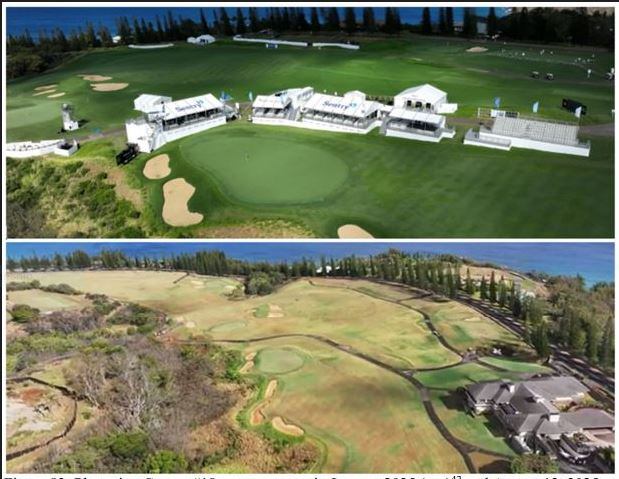West Maui Water Shortage: What It Means for Kapalua, Golf, and Maui Real Estate
Aloha friends, Eric West here from HawaiiRealEstate.org, coming to you from Kapalua on Maui’s west side. As the sun sets behind Molokaʻi, I want to talk about something that affects not only the fairways of the Kapalua Plantation Course but also the future of Maui real estate, tourism, and the island’s economy: water.
If you’ve visited recently, you’ve seen it yourself. Once emerald green, the world-famous Kapalua Plantation Course, where the PGA Tour usually kicks off each January, is now brown and struggling. Nearby neighborhoods like Mahana Ridge, known for their luxury Maui homes, are also watching their landscapes dry up as irrigation restrictions choke off water.
Here’s the irony: Mauna Kahalawai receives nearly 386 inches of rain each year, making it the second-rainiest spot on Earth. So why are we being told there’s a drought in West Maui?

A Lawsuit That Could Reshape West Maui Real Estate
This week, the issue escalated when Tadashi Yanai, billionaire founder of Uniqlo, filed a lawsuit against Maui Land & Pineapple Co. (MLP). Yanai’s company, which owns the Kapalua Plantation and Kapalua Bay golf courses, argues that MLP has failed to maintain the century-old Honokōhau Ditch System—the water lifeline that historically irrigated sugar and pineapple fields and now supports Kapalua’s resort community.
The lawsuit states that for 136 of the 154 days before filing, no irrigation water flowed at all. For the other 18 days, only 40% of historic water use was allowed. That leaves Kapalua golf courses, farmers, and homeowners associations high and dry—literally.
Yanai’s suit points out that the water shortage is not due to lack of rainfall, citing U.S. Geological Survey data showing the watershed above Kapalua receives more precipitation than cities like Seattle. Instead, the claim is that MLP neglected the infrastructure that carries rainwater to communities and resorts.
Maui Land & Pineapple’s Position
Maui Land & Pineapple, once a leader in pineapple production, is now primarily focused on real estate development and resort operations. The company insists it is following the directives of the state Commission on Water Resource Management (CWRM), which has designated West Maui as a special Water Management Area. Under those rules, water is prioritized first for cultural and traditional uses like taro farming, then for Lahaina’s drinking supply, leaving golf courses and landscaping last in line.
MLP’s CEO, Race Randle, described the situation as a “historic drought.” Still, many residents and property owners question how a drought exists when West Maui mountains receive hundreds of inches of rain each year.
What’s at Stake for Maui
This fight is about more than fairways turning brown. It touches every corner of the Maui economy:
-
Tourism – The PGA Tour stop at Kapalua draws global attention, bringing jobs and revenue to hotels, restaurants, and local workers. Losing it would be a major blow.
-
Property values – Whether you own a $500,000 condo or a $10 million Kapalua estate home, buyers expect reliable utilities. Diminished water access undermines the confidence of property investors in Maui luxury real estate.
-
Community trust – Residents who bought in Kapalua, Kāʻanapali, and other West Maui neighborhoods did so with the understanding that water infrastructure would be maintained. If those agreements fail, what’s next?
My Perspective as a Maui Real Estate Professional
I’ve seen firsthand how this narrative plays out. Rain hasn’t stopped falling on Mauna Kahalawai—it’s still pouring down daily, just as it has for centuries. For decades, this rainfall irrigated thousands of acres of sugarcane and pineapple. Now, with agriculture mostly gone, water demand is far lower, yet suddenly we’re told it’s not enough for a few golf courses and neighborhoods.
In my opinion, this isn’t about scarcity—it’s about management, priorities, and politics. And when water becomes a political tool, the people of Maui lose: homeowners, workers, farmers, and the broader tourism industry.
Final Thoughts
Looking out over the 18th hole at the Kapalua Plantation Course, I hope two things happen:
-
That the PGA Tour continues to start here, showcasing Maui’s beauty to the world.
-
That sensible solutions emerge so water once again flows reliably to the communities and properties that depend on it.
Because water isn’t just about keeping golf courses green. It’s about protecting property rights, sustaining Maui real estate values, supporting tourism, and ensuring that West Maui remains a thriving place to live, work, and visit.
Until next time, aloha from Kapalua.
Posted by Start An Offer on
Leave A Comment